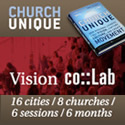Contrasting Healthy/Unhealthy Churches
- Posted by: Todd
- Posted on: Tue, December 06, 2005
- Viewed 110
- (61) comments so far
As I was preparing to teach a counseling course I was struck by the similarites between healthy and unhealthy groups and healthy and unhealthy churches. I took Cory's list and found relevant passages from Acts that described a healthy church."
Take a look at these and see what you think:
Healthy Church - Relies on the Holy Spirit (2:1-47)
Unhealthy Church - Relies on human effort
Healthy Church - Based on the Bible (2:42)
Unhealthy Church - Based on tradition
Healthy Church - Emphasis on grace (15:1-35)
Unhealthy Church - Emphasis on works-righteousness
Healthy Church - God gets all the credit (2:47)
Unhealthy Church - People get the credit.
Healthy Church - Faithfully practices the ordinances of baptism (2:41) and communion (2:42)
Unhealthy Church - Fails to practice these ordinances or
overemphasizes them.
Healthy Church - Diversity is encouraged (2:9-11), and there is a respect for individual beliefs and cultural differences
Unhealthy Church - Conformity is prized, and individual beliefs & cultural differences are devalued.
Healthy Church - Prayer is a priority (4:23-31)
Unhealthy Church - Prayer is talked about but not practiced
Healthy Church - Communication is clear & direct (15:22-35)
Unhealthy Church - Communication is unclear & indirect.
Healthy Church - Repentance is stressed (3:19)
Unhealthy Church - Repentance is whispered
Healthy Church - Members feel empowered (4:31) and share power with one another
Unhealthy Church - Members or leaders use power and control over others.
Healthy Church - Assemblies are dynamic; Inspiring worship (2:43, 4:23-31)
Unhealthy Church - Assemblies are dull, predictable and boring
Healthy Church - Thinking and questioning are encouraged (18:26)
Unhealthy Church - Thinking and questioning are discouraged.
Healthy Church - Obedient to God (4:19)
Unhealthy Church - People pleasing
Healthy Church - Members trust other members and leaders, or at least they openly express any lack of trust. (5:1-11)
Unhealthy Church - Mistrust is evidenced by an undercurrent
of unexpressed hostility.
Healthy Church - Culturally relevant while remaining doctrinally pure (17:16-34)
Unhealthy Church - Fixated on doctrine and uses out-of-date methods.
Healthy Church - Goals are clear and specific (1:8) and shared by the members - the church is lead to meet goals.
Unhealthy Church - Goals are fuzzy, abstract, and general.
Members have unclear personal goals or no goals at all.
Healthy Church - Most members feel a sense of inclusion, and excluded members are invited to become more active (2:44)
Unhealthy Church - Many members feel excluded and cliques are formed - there is fear of expressing feelings of being left out
Healthy Church - The leadership functions are shared by the group; people feel free to initiate activities and be creative (6:1-7).
Unhealthy Church - There are power conflicts among members and leaders. Creativity is discourage.
Healthy Church - Large group assemblies and small group sharing (20:20)
Unhealthy Church - Large group and middle size group only. Small groups are viewed with suspicion.
Healthy Church - Sin is confessed (19:18)
Unhealthy Church - Sin is hidden and rarely confessed
Healthy Church - Members give their money generously 4:32-37) ? the leaders are accountable and open in the way they handle funds
Unhealthy Church - Members are not charitable - the leaders are secretive and unaccountable.
Healthy Church - Organizational structure is functional and flexible (6:1-7). Gift-based ministry.
Unhealthy Church - Organizational structure in inflexible and dysfunctional. Haphazard ministry
Healthy Church - Needs-oriented evangelism (1:8)
Unhealthy Church - Evangelism is rare - few people are saved
Healthy Church - Cooperates with other churches in ministry (21:18 & 24:17)
Unhealthy Church - Isolates themselves from other churches - exclusive and sectarian.
Healthy Church - Cohesion is high; there is a close emotional bond among members. Members share with each other (2:44-45).
Unhealthy Church - Division exists; people feel distant
from one another. There is a lack of caring and empathy.
Healthy Church - Organized ministry for the poor (6:1-7)
Unhealthy Church - No organized outreach to the poor
Healthy Church - Men and women are free to pray and prophesy (1:14, 2:17, 4:24, 21:9)
Unhealthy Church - Women and young girls are excluded from full participation in assemblies & small groups
Healthy Church - Loving relationships permeate every aspect of the church ( 20:36-38)
Unhealthy Church - Members are distant from each other
Healthy Church - Conflict among members or with leaders is recognized, discussed, and often resolved (6:1-8, 15:1-30 & 36-41)
Unhealthy Church - Conflict or negative feelings are ignored, denied, or avoided.
Healthy Church - Passionate spirituality (18:28)
Unhealthy Church - Lack of enthusiasm - low morale
FOR DISCUSSION: Think about each statement as it relates to your church. Identify strengths and build on them. Identify weaknesses and take measures to improve those areas. Work to improve the health of your church knowing that your salvation is secure. You are the church of God. One day Jesus will present his church to himself as perfect, without blemish. Until that time we pray and rely on the Holy Spirit as we strive to be all the Lord wants us to be as a church.
Jeff Garrett has a nice post over at his blog on the differences between a healthy and an unhealthy church. Jeff explains, "This list of characteristics of a healthy church is adapted from Cory and Cory’s description of healthy groups in: Theory and Practice of Group Counseling…
Comments
if you want a Globally Recognized Avatar (the images next to your profile) get them here. Once you sign up, they will displayed on any website that supports them.






Phil Hoover-Chicago on Tue, December 06, 2005
Great post…
Every local congregation should have this listed in their weekly bulletins.
For a long time.
Bernie Dehler on Tue, December 06, 2005
“Unhealthy Church - Members are not charitable - the leaders are secretive and unaccountable.”
I’d also say an unhealthy church teaches that you must tithe, to get blessed. If you don’t tithe, you’re under a curse. Teach that people must tithe by mis-applying Malachi ch 3, and not teaching Malachi in context.
Healthy: teach true stewardship, as in the parable of the talents. We are accountable for all we have received by God, not just 10% of the increase. And if you’re poor, you shouldn’t be robbed in the name of God, but rather helped.
Here’s an example of how NOT to do it:
http://www.amazon.com/gp/product/0899008240/104-3542579-3745518?v=glance&n=283155
(My review is on the webpage.)
Tony on Tue, December 06, 2005
Wow!
My wife and I were having a discussion about this just earlier this morning. This is definately being printed out, prayed over and will be used in the near future.
Thanks Todd!
Blessings,
Tony
Abbey on Tue, December 06, 2005
I agree.
Abbey on Tue, December 06, 2005
I agree with Phil, not necessarily Bernie.
Linda on Tue, December 06, 2005
Excellent!!!
Pete King on Tue, December 06, 2005
Very thorough. Speaking from personal experience I agree entirely. The list could be improved by being more case/church specific but in general this is an excellent check off list. Great post Todd.
Wendi on Tue, December 06, 2005
I love the contrasts within the elements of health:
• Emphasis on grace PLUS on repentance and confession of sin
• Diversity, thinking and questioning encouraged PLUS doctrinal purity
• Need based evangelism and outreach to the poor PLUS high cohesion and strong emotional ties among members.
I think the diversity PLUS doctrinal purity is the hardest to pull off. On another post (I think it was “Just believe and shut up”), BeHim and Peter (if you’re reading) seemed to agree that there are not multiple “correct or acceptable” interpretations of scripture. I disagree.
Joseph Arminius and John Calvin and now their followers, espouse completely different “correct” interpretations of scripture regarding election and eternal security. Dispensational and Covenant theologians have completely different “correct” interpretations of scripture regarding the end times. Similarly dispensationalists interpret scripture regarding the function of the Holy Spirit today and the “sign gifts” in a completely different way than do Pentecostals and Charismatic denominations. Some denominations interpret I Tim. 2 as normative and restrict the ministry of women while others interpret it as descriptive and contextual and ordain women. These are just a few, but are they not different and acceptable interpretations of scripture? No matter which side any of us lands on the interpretive examples above – we’ll all share eternity together, right? Doesn’t that make either interpretation acceptable?
So my question related to this post is how much diversity of theological and interpretive opinion can exist among members of a particular church if it is to be healthy? If we can learn to say “I interpret scripture to say . . .” rather than “scripture says . . . “ can significantly different interpretations and theological positions be held among members of the same local church?
I think so, if respectful discussions, thinking and questioning is encouraged. In fact, I maintain that when inspiring the writers of scripture, the Holy Spirit intentionally left some things disputable, so that we could have unity amidst diversity . . . and model for the lost world a healthy body.
Bernie Dehler on Tue, December 06, 2005
Wendi wrote:
“If we can learn to say “I interpret scripture to say . . .” rather than “scripture says . . . “ can significantly different interpretations and theological positions be held among members of the same local church?”
But you have to put a line in the sand somewhere. There are those who call themselves Christians but don’t believe in the fundamentals, such as Jesus rising from the dead. Some teachings also create great damage, I think, such as the health and wealth gospel that is infiltrating local churches from “Christian” TV.
Wendi on Tue, December 06, 2005
Bernie,
Yes, we do need to draw a line around the circle of orthodoxy, only those things related to salvation such as the deity of Christ and as you pointed out, His bodily resurrection. But I think too often (as evidenced in the blog world) we toss methodology into our circle of orthodoxy. Or . . . we pick statements from books or sermons, taken out of context, and try to prove some pastor or his church is compromising orthodoxy. I don’t think that is fair.
That’s not to say that I don’t think there are those who water down their message or preach a “prosperity gospel” - of course there are. I just think we’re wasting so much time trying to find the chinks in the armor of Christian leaders that we’ve become “unhealthy” as Garrett points out.
As another example, my pastor is not afraid to address the sin of abortion, but we will never have a bulletin insert that says “Abortion kills babies” or rally our people to picket abortion clinics. We’ve made this choice because we want a woman who might have had a past abortion to feel grace from us, she can’t get her baby back after all. We support the local Crisis Pregnancy Center with volunteers and resources. These represent different “methods” or ways for a church to live out a biblical truth that they share a commitment to. However, some in our community have tossed picketing and political activity into their “circle of orthodoxy,” accusing us of being “soft” on the biblical truth related to sanctity of life because we refuse to participate in such things. That is not fair, and its not true.
bishopdave on Tue, December 06, 2005
Excellent, yes it must be copied and distributed. I may use this on our elders retreat in January and just ask them if, based on these ideas, are we healthy or not? And by all means, pick your pet peeve and dwell there. Everybody I know who teaches Malachi 3 (including myself) teach it in conjunction with stewardship, and teach 2 Corinthians 8 & 9, etc. Malachi is inspired also. Please, Lord, let us turn this thread from self-examination into a discussion on legalism and discontinuity between Your Old and New Testaments.
Bernie Dehler on Tue, December 06, 2005
BishopDave says:
“Everybody I know who teaches Malachi 3 (including myself) teach it in conjunction with stewardship”
Dave- ever teach Malachi 2? I doubt it. I’ve heard lots of tithe teaching in my life, and I NEVER heard Mal. ch. 2 mentioned… you’d think Malachi only had one chapter, ch. 3. I challenge you next time you teach about Malachi, try teaching it in context. Include Malachi Ch. 2.
Also about 2 Corinthians… it’s not a collection for the church building or ministry or Pastor (as tithes are primarily used for today). It was for the poor living in Jerusalem. Another example of tithe-scripture twisting. Church members would give like they did in Corinthians if it was for the poor and needy, rather than for a megahurch structure.
Stewardship does not mean handling the 10% of your increase correctly (giving it to the local church). It means managing ALL your time and treasure for the Lord.
Just my opinion, but I think it’s very important in the topic of a healthy church. I agree Malachi is inspired, but that doesn’t mean it can be twisted to mean something it’s not meant to.
bishopdave on Tue, December 06, 2005
Bernie,
I love this, have I ever preached Malachi? Yes sir, I have preached Malachi 3. And 2. Yes, I did it in context. Did the whole book in a series of 7 sermons. Want proof go to http://foxavebapt.com/Sermons/Sermons 2004.htm and you will find the outlines, from 7/11 to 8/29. I’m sure the outlines aren’t enough to prove anything to you, but they’re there.
Your response to me supports what bothered me about your first post on this thread. I’m sure you grasp that tithing was in fact God’s first big lesson in stewardship. Much of those offerings in the OT went for temple and priest (building & staff) support. Apparantly support of the local body was ok in the OT. In the NT, we see in the pastoral epistles that support paying salary is ok (admittedly they didn’t have a building; they didn’t have websites or radio either, those too are expensive overhead). A healthy church does have some overhead, and it is honoring to God, and healthy, for the church to take care of its responsibilities. But the truth is you just hate megachurch structures, and that’s all you really meant, right? My pet peeve is Jesus loves His imperfect church (He loved the 7 churches in Rev 2&3;so much He wrote them letters about His heart for them—Jesus loves Thyatira and Laodecia), but so many bloggers have seen a bad experience with tithing or whatever and teaching on tithing is therefore wrong. Would some of you bloggers have thought Christianity stood a chance of survival if you were a member of the Corinthian church and observed that mess while your were growing up in the youth group? Most of those NT epistles were written to very unhealthy churches. And the health and wealth teaching is a sign of an unhealthy church. But teaching tithing as PART of the overall stewardship of one’s life is a sing of a healthy church.
Your accusation of scripture twisting troubles me, and I would question your hermenuetics (the way you practice interpretation). So, does the Lord only love the cheerful givers who give to the poor since it’s also in that context? Where are the limits of application in 2 Cor 8 & 9? Does your hermenuetic allow the underlying principle of a passage to be applied in different settings—i.e., can 2 Cor 8&9;be applied to support of foreign missions as opposed to just the poor? Can the idea of “sow sparingly, reap sparingly” be applied to the overall concept of all stewardship or just to giving to the poor?
A healthy church practices good interpretation and application of the Bible.
bernie dehler on Wed, December 07, 2005
Hi Bishop Dave-
Wow, you’re the first tithe teacher I ever heard that mentioned Mal. ch. 2. However, looking at your outline notes, I don’t really see you explaining the text about the crooked Priests. I wish you had an audio download so I can hear more of what you actually taught.
On your link about “robbing God,” I see many of the old repeated errors (your link http://foxavebapt.com/Sermons/Sermon Outlines/2004/08-22-04.pdf ). Let me hit the first point, your foundation. You say 1 Cor. 16:2 is a command to tithe. Do you seriously think so? Verse 1 (the prior verse) says what the collection is for, and it’s not the tithe. It’s for the special Jerusalem fund. Curious, do you knowingly misrepresent this, or are you just repeating what the other tithe teachers preach? I’d really like to know… And this is the best that tithing teachers can come up with because there is no tithing verses in the New Testament. Look in Acts how the early believers lived; everything in common, not just 10%. They met in houses and at the temple. They were ready for the Lord to return at any minute, not thinking about starting a building fund. I’m not against churches and building funds, but I am against false tithe teaching.
Even though we disagree on this, I still love you as a brother. Keep up the good fight.
bishopdave on Wed, December 07, 2005
Well Bernie you caught me. Yes I pursposefully distort the Bible in order to lead the masses astray. That’s why the outlines are so vague and without context. That’s why I mindlessly follow what other tithe preachers say, then I don’t have to interact with the Holy Spirit or the Word.
And I’m not sure you practice good reading comprehension. What was the gist of my post about tithing and it’s place in stewardship? I told you the outlines probably wouldn’t be enough. I also asked you about application. The outlines are primarily the highlights and applications from the message that we put in the bulletin. The outline does give you clues that we did deal with the priests—read it again. Again I ask you, how do you practice application in your teaching? Yes, Mal 2.1-9 is about priests. What is a priest? (oops, the outline deals with that too). I applied the message to leaders and their need to walk the talk, hence the title. How do you apply an OT message about priests to NT believers? 1co 16:2—is setting aside a proportion of your resources on the first day of the week a good practice or not? What should the proportion be? These are application questions. And, when you don’t practice good stewardship, you rob God.
Again, a healthy church practices good hermeneutics and application.
Just because I differ from you on interpretation doesn’t mean I “twist the scripture.” I’m insulted by that comment, and tossing in the “I love you as a brother” reeks in insincerity.
Page 1 of 5 pages 1 2 3 > Last »
Post a Comment